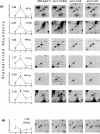Yeast Asc1p and mammalian RACK1 are functionally orthologous core 40S ribosomal proteins that repress gene expression
- PMID: 15340087
- PMCID: PMC515043
- DOI: 10.1128/MCB.24.18.8276-8287.2004
Yeast Asc1p and mammalian RACK1 are functionally orthologous core 40S ribosomal proteins that repress gene expression
Abstract
Translation of mRNA into protein is a fundamental step in eukaryotic gene expression requiring the large (60S) and small (40S) ribosome subunits and associated proteins. By modern proteomic approaches, we previously identified a novel 40S-associated protein named Asc1p in budding yeast and RACK1 in mammals. The goals of this study were to establish Asc1p or RACK1 as a core conserved eukaryotic ribosomal protein and to determine the role of Asc1p or RACK1 in translational control. We provide biochemical, evolutionary, genetic, and functional evidence showing that Asc1p or RACK1 is indeed a conserved core component of the eukaryotic ribosome. We also show that purified Asc1p-deficient ribosomes have increased translational activity compared to that of wild-type yeast ribosomes. Further, we demonstrate that asc1Delta null strains have increased levels of specific proteins in vivo and that this molecular phenotype is complemented by either Asc1p or RACK1. Our data suggest that one of Asc1p's or RACK1's functions is to repress gene expression.
Figures






Similar articles
-
Critical Role for Saccharomyces cerevisiae Asc1p in Translational Initiation at Elevated Temperatures.Proteomics. 2018 Dec;18(23):e1800208. doi: 10.1002/pmic.201800208. Epub 2018 Oct 23. Proteomics. 2018. PMID: 30285306 Free PMC article.
-
Direct link between RACK1 function and localization at the ribosome in vivo.Mol Cell Biol. 2009 Mar;29(6):1626-34. doi: 10.1128/MCB.01718-08. Epub 2008 Dec 29. Mol Cell Biol. 2009. PMID: 19114558 Free PMC article.
-
Asc1p/RACK1 Connects Ribosomes to Eukaryotic Phosphosignaling.Mol Cell Biol. 2017 Jan 19;37(3):e00279-16. doi: 10.1128/MCB.00279-16. Print 2017 Feb 1. Mol Cell Biol. 2017. PMID: 27821475 Free PMC article.
-
Regulation of eukaryotic translation by the RACK1 protein: a platform for signalling molecules on the ribosome.EMBO Rep. 2004 Dec;5(12):1137-41. doi: 10.1038/sj.embor.7400291. EMBO Rep. 2004. PMID: 15577927 Free PMC article. Review.
-
Structural analysis of ribosomal RACK1 and its role in translational control.Cell Signal. 2017 Jul;35:272-281. doi: 10.1016/j.cellsig.2017.01.026. Epub 2017 Feb 2. Cell Signal. 2017. PMID: 28161490 Review.
Cited by
-
RACK1 Function in Cell Motility and Protein Synthesis.Genes Cancer. 2013 Sep;4(9-10):369-77. doi: 10.1177/1947601913486348. Genes Cancer. 2013. PMID: 24349634 Free PMC article. Review.
-
Molecular mechanisms of hypoxic responses via unique roles of Ras1, Cdc24 and Ptp3 in a human fungal pathogen Cryptococcus neoformans.PLoS Genet. 2014 Apr 24;10(4):e1004292. doi: 10.1371/journal.pgen.1004292. eCollection 2014 Apr. PLoS Genet. 2014. PMID: 24762475 Free PMC article.
-
Noncanonical Gβ Gib2 is a scaffolding protein promoting cAMP signaling through functions of Ras1 and Cac1 proteins in Cryptococcus neoformans.J Biol Chem. 2014 May 2;289(18):12202-16. doi: 10.1074/jbc.M113.537183. Epub 2014 Mar 21. J Biol Chem. 2014. PMID: 24659785 Free PMC article.
-
New evidence for differential roles of l10 ribosomal proteins from Arabidopsis.Plant Physiol. 2013 Sep;163(1):378-91. doi: 10.1104/pp.113.223222. Epub 2013 Jul 25. Plant Physiol. 2013. PMID: 23886624 Free PMC article.
-
Ribosomal RACK1 promotes chemoresistance and growth in human hepatocellular carcinoma.J Clin Invest. 2012 Jul;122(7):2554-66. doi: 10.1172/JCI58488. Epub 2012 Jun 1. J Clin Invest. 2012. PMID: 22653060 Free PMC article.
References
-
- Alban, A., S. O. David, L. Bjorkesten, C. Andersson, E. Sloge, S. Lewis, and I. Currie. 2003. A novel experimental design for comparative two-dimensional gel analysis: two-dimensional difference gel electrophoresis incorporating a pooled internal standard. Proteomics 3:36-44. - PubMed
-
- Angenstein, F., A. M. Evans, R. E. Settlage, S. T. Moran, S. C. Ling, A. Y. Klintsova, J. Shabanowitz, D. F. Hunt, and W. T. Greenough. 2002. A receptor for activated C kinase is part of messenger ribonucleoprotein complexes associated with polyA-mRNAs in neurons. J. Neurosci. 22:8827-8837. - PMC - PubMed
-
- Asano, K., L. Phan, T. Krishnamoorthy, G. D. Pavitt, E. Gomez, E. M. Hannig, J. Nika, T. F. Donahue, H. K. Huang, and A. G. Hinnebusch. 2002. Analysis and reconstitution of translation initiation in vitro. Methods Enzymol. 351:221-247. - PubMed
-
- Ceci, M., C. Gaviraghi, C. Gorrini, L. A. Sala, N. Offenhauser, P. Carlo Marchisio, and S. Biffo. 2003. Release of eIF6 [p27(BBP)] from the 60S subunit allows 80S ribosome assembly. Nature 426:579-584. - PubMed
Publication types
MeSH terms
Substances
Grants and funding
LinkOut - more resources
Full Text Sources
Molecular Biology Databases
